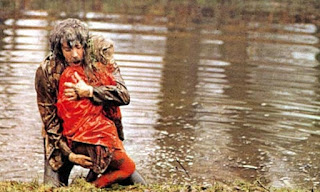Art and Film.
Mothers, Fathers and Dead Children.
 |
| Illustration 1: 'Mother Weeping For Her Dead Child' ('Moeder Beweent Haar Dood Kind'), 1886, sculpture; George Minne; Museum of Fine Arts, Ghent. |
'Mother Weeping For Her Dead Child', by the Belgian sculptor George Minne, powerfully predicts the nineteenth century, fin-de-siècle obsession with 'Eros and Thanatos' ('Death' being very much in the foreground here). There is also an older, Gothic influence which can be felt in the emotive manipulation of limbs and bodily contortion. This points forward to Expressionism, with its emphasis upon violent emotion emerging from psychological anguish. Minne displays great sympathy, I think, for the suffering individual.
In his sculpture, we can sense the dead boy's inert weight, and a life-force which still moves in the grieving parent. Life and pain have become synonymous. Two bodies seem to merge, and yet are separate - wrenched apart (a corpse no longer being of the same substance as a vital, living being). This conflict is expressed through the mother's extreme pose and counter-pose, as she moves forward and into her child; but also backwards and away from it (in the twisting of upper-body, neck and head) [Illustration 2]:
 |
| Illustration 2: the child is held close but the mother twists away. |
 |
| Illustration 3: 'Don't Look Now', 1973, film: Nicolas Roeg, director; Anthony B. Richmond, cinematographer. |
I feel that this sequence from 'Don't Look Now' (Illustration 3) is comparable in effect - partly because of its viewpoint. A father, 'John Baxter' (
Donald Sutherland, actor), embraces his drowned daughter, 'Christine'. An aerial perspective emphasises both the weight-of-water and a body's mass, as well as the physical effort required to hold or lift someone. (The stable base of Minne's sculpture, which is bottom-heavy, likewise conveys this feeling of dead matter being pulled down.) A cry of pain is intensified by being directed upward and away from the source of grief (Illustration 4):
 |
| Illustration 4: a body is drawn in and a cry of pain is directed outwards. |
Minne seems to be searching for an essential, symbolic pose in which bodily movement acquires a metaphysical character. There's a sensation of pure pain that has been suspended or paralysed. 'Don't Look Now' is a movie which explores temporal ambiguity, using a technique of 'parallel editing' (or 'cross cutting'). Its belief in precognition implies a deeper layer of time, or timelessness, in which death and fate are intertwined. Roeg inserts the 'drowning scene' (with slow motion, artificial lighting and overhead view) into an equally harrowing, but literal, representation of the father entering, then emerging from, a lake (Illustration 5):
 |
| Illustration 5: emerging. |
The contrast leaves a lingering vision of endless, infinite grief existing in a spatio-temporal realm that goes beyond the natural or 'real'.




